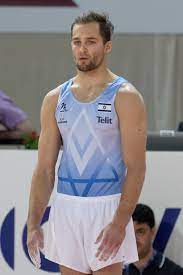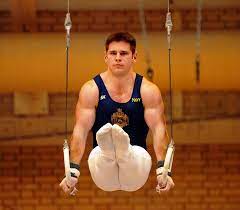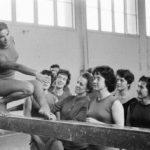Can tall male gymnasts be any good? In the world of gymnastics the subject of height has always piqued interest and curiosity. The general perception of gymnasts both male and female is that being short is an advantage however, there are plenty of examples where being taller has not prevented success.
When we speak of “tall” in the context of gymnastics, it typically refers to male gymnasts who are above the height of 5 feet 9 inches.

Why Height Matters in Gymnastics
Height plays a multifaceted role in gymnastics, affecting various aspects of a gymnast’s performance. The impact of height on strength and flexibility is notable, with taller gymnasts often having greater reach but needing to adapt to control their larger frames.
The effect of height on the mechanics of gymnastics skills is proven in numerous scientific studies. Height and mass affect inertia, rotation and the base of support which all underpin how a gymnastics skill, such as a somersault, is executed.
Various apparatuses in male gymnastics are affected by height especially where the leverage and reach advantages may be more pronounced in some events and less in others.
A comparison of tall and short gymnasts’ performance reveals that height can be both an advantage and a challenge, requiring specific training and techniques to optimize performance.
Height in gymnastics is just one attribute that contributes to a gymnast’s success or failure. Others include:
- Strength
- Flexibility
- Power
- Speed
- Self Confidence
- Resilience
Therefore it’s impossible to define a gymnast purely on how tall they are but it should be considered alongside a multitude of factors.
History of Tall Male Gymnasts
The trend for shorter, stockier gymnasts has been evident since the 1970s and is synonymous with teen gymnasts such as Olga Korbut and Nadia Comăneci.
But what about their male counterparts?
The records point to a gradual shift towards shorter male gymnasts from around the same time period as well. It is fair to say that male gymnastics is often overshadowed by the women’s side of the sport which may explain why there is less focus on the height of male gymnasts.
Veikko Huhtanen of Finland was crowned the male All Around winner at the 1948 Olympic games, measuring in at a fairly average 5 feet 9 inches.
Every male Olympic champion since 1948 has been shorter than Huhtanen’s 5 feet 9 inches.
This history paints a picture of a sport that doesn’t favor tall gymnasts but there are still many notably tall male gymnasts that have achieved success in the sport.
The Tallest Male Gymnasts
The world of gymnastics has seen several tall male gymnasts who have left an indelible mark on the sport. Their profiles and techniques offer fascinating insights into how they have used their height to their advantage. Some of these athletes include:
- Russ Czeschin (6 feet 3 inches): Highly successful NCAA college gymnast. A four-time Academic All-American.
- Alexei Nemov (5 feet 8.5 inches): Olympic All-Around Champion, Sydney, 2000. His elegant style and innovative routines made him a standout figure in gymnastics history.
- Alexander Shatilov (6 feet): 3-time Israeli Olympian who specializes on floor exercise.
These gymnasts, among others, have not only achieved individual success but also contributed to the growth and understanding of how taller gymnasts can be successful.

Changes Over Time
Gymnastics witnessed a significant shift in perception, training regimes, and equipment evolution in the 1970s and early 1980s. The gymnastics world before this period was not particularly focused on height as an important factor, but with time, the sport began recognizing and adapting to the benefits and challenges that shorter gymnasts brought.
Equipment became geared towards high performance and this enabled gymnasts to really push their limits.
Training methodologies evolved, incorporating specific exercises and routines to cater to shorter gymnasts but as the 1990s drew to a close it became apparent that not all gymnasts had to be short.
Advantages and Challenges of Being a Tall Gymnast
Tall gymnasts have a unique set of advantages and challenges that define their journey in the sport:
| Advantage | Challenge |
|---|---|
| Greater leverage in some events | Control in rotations can be more difficult |
| Ability to reach greater distances such as release and catch on the high bar | Increased risk of injuries |
| Potential for more dramatic presentations | Challenges in maintaining flexibility |
These characteristics are not mere observations but critical aspects that affect training, performance, and success in competitions. The leverage and reach advantages give tall gymnasts a distinctive edge in some events, while control and flexibility can pose challenges that require tailored training and careful attention.
Understanding these nuances provides a deeper insight into the life and career of a tall gymnast, opening doors to specialized training techniques, strategies, and the unending pursuit of excellence.
Which Events Are Suited to Tall Male Gymnasts
Different gymnastic events present varying levels of suitability for tall male gymnasts. A detailed analysis is as follows:
- Floor Exercise: More suited for tall gymnasts due to their reach and dramatic presentation.
- Pommel Horse: Can be challenging due to the need for precise control and flexibility.
- Still Rings: Provides an opportunity for greater leverage, but balance may be a challenge.
- Vault: Advantageous for tall gymnasts, allowing for powerful leaps and distance.
- Parallel Bars: Requires adaptation for control, but height can add to the aesthetic appeal.
- Horizontal Bar: A mixed bag, where reach can be an advantage, but rotations may be more complex.

Understanding the specific advantages and challenges of each event allows tall gymnasts to tailor their training and strategies, playing to their strengths and working on areas that require improvement.
Training Techniques for Tall Male Gymnasts
Specialized training regimes are essential for tall gymnasts, focusing on the unique physical attributes they bring to the sport. Some key techniques include:
- Strength Training: Targeting specific muscles to support greater control and leverage.
- Flexibility Exercises: Emphasizing stretches and routines that maintain and enhance flexibility.
- Customized Routines: Designing practices that align with the events where tall gymnasts excel.
These techniques, coupled with insights from case studies of successful training routines, form the basis of training regimes that can optimize the performance of tall gymnasts.
Success Stories
Tall male gymnasts have amassed a collection of achievements that attest to their skills and resilience:
- Olympic Victories: Alexei Nemov – All Around Olympic Champion 2000, Vitaly Scherbo – All Around Champion 1992
- World Championship Triumphs: Alexander Shatilov – Bronze floor 2009 and 2011.
- European Records: Igor Cassina 5 feet 11 inches – Horizontal Bar medalist at the Olympics, World Championships and European Championships.
Tall gymnasts have also contributed significantly to team successes, playing leading roles in national teams and helping secure critical victories in team competitions.
The Future of Tall Male Gymnasts
The future looks promising for tall male gymnasts, with emerging talents and continuous evolution in training and techniques. Key areas of focus include:
| The Future Aspect | Description |
|---|---|
| Emerging Talents | New gymnasts showcasing potential in regional and international competitions |
| Predictions for Upcoming Competitions | Expectations of strong performances and potential victories by tall gymnasts |
| Potential Evolution | Anticipation of continued changes in training, rules, and equipment to include tall gymnasts |
FAQs
Are there any tall male gymnasts?
Yes, there have been and continue to be tall male gymnasts in the sport. Some notable names include Vitaly Scherbo, Alexei Nemov, and Alexander Shatov. These gymnasts have proven that height can be an advantage in certain aspects of gymnastics and have achieved significant success.
What is the average height for a male gymnast?
The average height for male gymnasts typically ranges from 5 feet 4 inches to 5 feet 8 inches (162 to 173 cm). This can vary based on the level of competition and the country or region, but it gives a general idea of what is considered the norm in the sport.
How tall are elite male gymnasts?
Elite male gymnasts’ height can vary widely, but it often falls within the range mentioned above. Some elite gymnasts may be shorter, around 5 feet 4 inches, while others may be taller, reaching heights of 5 feet 10 inches or more. It’s worth noting that elite gymnasts’ training and techniques often allow them to leverage their height, whether tall or short, to their advantage.
Can a gymnast be 6 feet tall?
Yes, a gymnast can be 6 feet tall or even taller. While it is less common, there have been gymnasts of this height who have competed successfully at high levels such as Alexander Shatov from Israel. It’s worth remembering that there are no height limits in gymnastics.
Being 6 feet tall brings unique advantages and challenges, and with the right training and techniques, a gymnast of this height can excel in the sport.
Can gymnastics stunt your growth?
There is some evidence that elite gymnasts can have delays in their bone growth. Any stunt in growth then recovers after the gymnast retires and is not believed to be dangerous.
Sources:
Role of Intensive Training in the Growth and Maturation of Artistic Gymnasts. R Malina et al 2013
Historical Changes in height, mass and age of USA Team. WA Sands et al updated 2018
- A Complete Guide to Gymnastics Hand RipsAre you tired of dealing with painful gymnastics rips on your hands from training? Look no further – this article offers a comprehensive approach… Read more: A Complete Guide to Gymnastics Hand Rips
- Is Gymnastics Dangerous? (Facts and Comparisons)Gymnastics is acknowledged as a highly technical and physically demanding sport. It inherently carries a risk of injury, which is why most coaches and… Read more: Is Gymnastics Dangerous? (Facts and Comparisons)
- The Fascinating Evolution of Gymnastics (History and Facts)Gymnastics is a sport that has been around for centuries and has evolved significantly throughout history. From its origins in ancient Greece to the… Read more: The Fascinating Evolution of Gymnastics (History and Facts)
- The Ultimate Parallel Bars Skills ListParallel bars are one of the most challenging events in men’s gymnastics. Mastering the right moves first on parallel bars is essential to improving… Read more: The Ultimate Parallel Bars Skills List
- The Long-Term Effects of Gymnastics on the Body (A Complete Guide)While gymnastics can offer many benefits, such as improved fitness and self-confidence, many people also ask what are the Long-Term Effects of Gymnastics on… Read more: The Long-Term Effects of Gymnastics on the Body (A Complete Guide)
- What Age Does Competitive Gymnastics Start?Ever wondered what age does competitive gymnastics start? It’s well known that gymnasts start training at a young age to develop the skills and… Read more: What Age Does Competitive Gymnastics Start?






